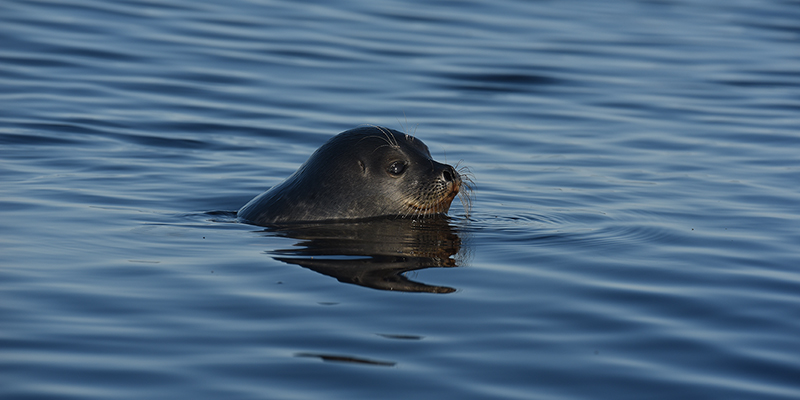In lair counts and examinations of nesting sites in Saimaa, 100 Saimaa ringed seal pups were observed this year, which is the largest number in the entire history of pup counts. The divers´s work was led by Metsähallitus, Parks & Wildlife Finland.
Thanks to last winter’s heavy snows and favourable breeding conditions for the Saimaa ringed seal, pup mortality rate appears to have been low, similarly to the year before. While the entire breeding area has now been inspected, more accurate figures may be obtained in connection with the population estimate produced in the autumn.
– One hundred pups is a ten out of ten result. The record-breaking birth rate is explained by thriving females and new individuals having survived and reached the reproductive age, says Miina Auttila, Senior Specialist in Nature Conservation at Metsähallitus, Parks & Wildlife Finland. – It is likely that the background factors for the large number of pups include good breeding conditions during two snowy winters as well as the expansion and consolidation of areas subject to fishing restrictions in recent years. This means that an increasing number of pups survive till adulthood, Auttila points out.
The pup numbers have gone up especially in Lake Pihlajavesi, where the seal population has grown steadily in recent years. In lake areas south of Savonlinna, both the population size and number of pups born have increased, whereas no similar increases have been found north of Savonlinna. While more pups than before were born in Joutenvesi, there were no signs of any young in Pyhäselkä–Jänisselkä or Pyyvesi areas.
As the Saimaa ringed seal population has recovered, the breeding area has expanded, and pups are now being born in the margins and outside of the restricted fishing areas in Pihlajavesi, Puruvesi and southern parts of Saimaa.
– More pups are moving outside the restricted fishing areas, where they run a higher risk of being caught in fishing gear. This is why we would like to see people using gear that is safe for seals rather than nets, also outside the restricted areas and closed se ason, says Ismo Marttinen, WWF Regional Manager. Seal-friendly fishing gear includes traps where the opening does not stretch beyond 15 cm and fyke nets modified to keep seals safe.

Man-made snow drifts and artificial lairs provide additional protection
Man-made snow drifts are one of the key conservation measures to help seals.
– Snow is nowadays shovelled into drifts in early winter every year to provide lair sites for seals, as predicting the snow conditions during the breeding season is not possible, says Riikka Alakoski, Senior Specialist at Metsähallitus. – A large number of natural snow drifts appeared in late February, and most seals nested in them. However, one in five pups was born in a man-made drift, in addition to which the seals used more than 60 of the man-made snow drifts to rest for a while, Alakoski says.
A project titled Our Saimaa Seal LIFE is also developing floating artificial lairs for the seals to use in mild winters
– This year, a ringed seal lived in one out of three of the twenty or so artificial lairs. Some seals used them in early winter but opted for sheltering in natural snow drifts after heavy snowfalls in February. Once the snow had melted later in the spring, however, they were again happy to take a rest in the man-made lairs, reports Mervi Kunnasranta, Senior Researcher at the University of Eastern Finland. – Despite the thick layers of snow last winter, two pups sheltered in artificial lairs. The mothers of both pups had also given birth in man-made lairs before, which seems to indicate that seals have accepted them as backup if there is no natural snow, says Kunnasranta.
Metsähallitus is responsible for monitoring the Saimaa ringed seal population and carrying out a large share of the conservation measures. WWF participates in producing man-made snow drifts and carrying out lair counts in the southern part of Lake Saimaa, and the University of Eastern Finland is closely involved in the protection measures of the Saimaa ringed seal and provides a scientific foundation for the conservation work. Metsähallitus coordinates a network of more than 300 volunteers who participate in building snow drifts and counting lairs. Local volunteers who know the area and its conditions are invaluable in the practical work of protecting and monitoring the Saimaa ringed seal.
The Saimaa ringed seal is an endangered subspecies, and according to the latest population estimate, around 440 individuals live in the waters of Lake Saimaa. The population monitoring and conservation methods are being developed as part of Our Saimaa Seal LIFE project funded by the EU, which will continue until the end of 2025.
Further information:
Population:
Miina Auttila, Senior Specialist, Nature Conservation: Metsähallitus, Parks & Wildlife Finland, tel. +358 40 637 6324, miina.auttila@metsa.fi
Lair counts and man-made snow drifts:
Riikka Alakoski, Senior Specialist, Nature Conservation: Metsähallitus, Parks & Wildlife Finland, tel. +358 40 530 7241, Riikka.alakoski@metsa.fi
Ismo Marttinen, Regional Manager: WWF Finland, tel. +358 50 434 9591, ismo.marttinen@wwf.fi
Artificial lairs:
Senior researcher Mervi Kunnasranta: University of Eastern Finland, tel. +358 50 371 3408, mervi.kunnasranta@uef.fi
Pups observed in 2023 by area
Water area / Number of pups observed
Pyhäselkä–Jänisselkä / 0
Orivesi / 1
Pyyvesi–Enonvesi / 1
Kolovesi / 1
Joutenvesi / 7
Haukivesi / 19
Pihlajavesi / 43
Puruvesi / 3
Tolvanselkä–Katosselkä / 8
Luonteri / 3
Lietvesi / 4
Petraselkä–Yövesi / 7
Suur-Saimaa / 3
Altogether / 100